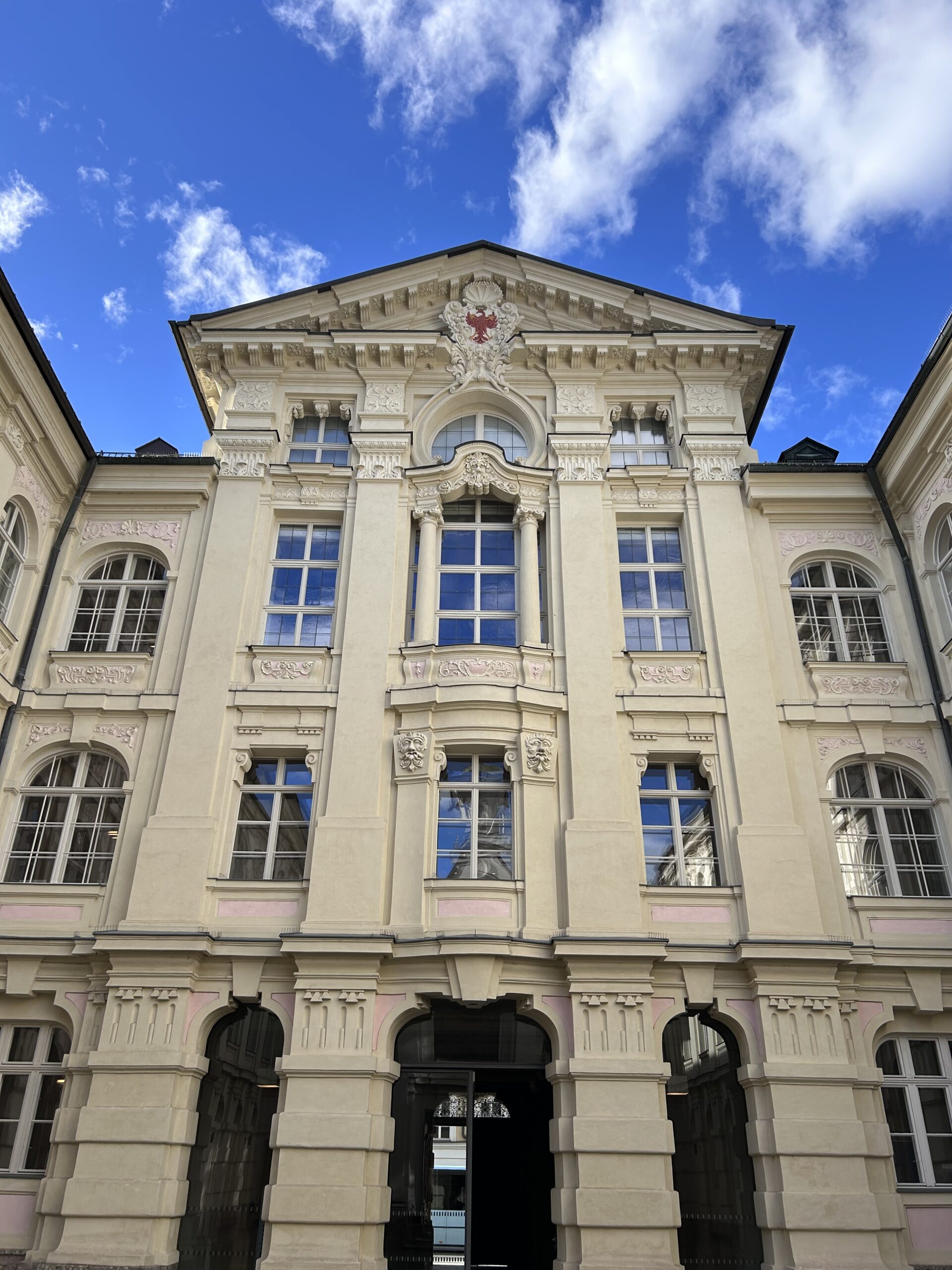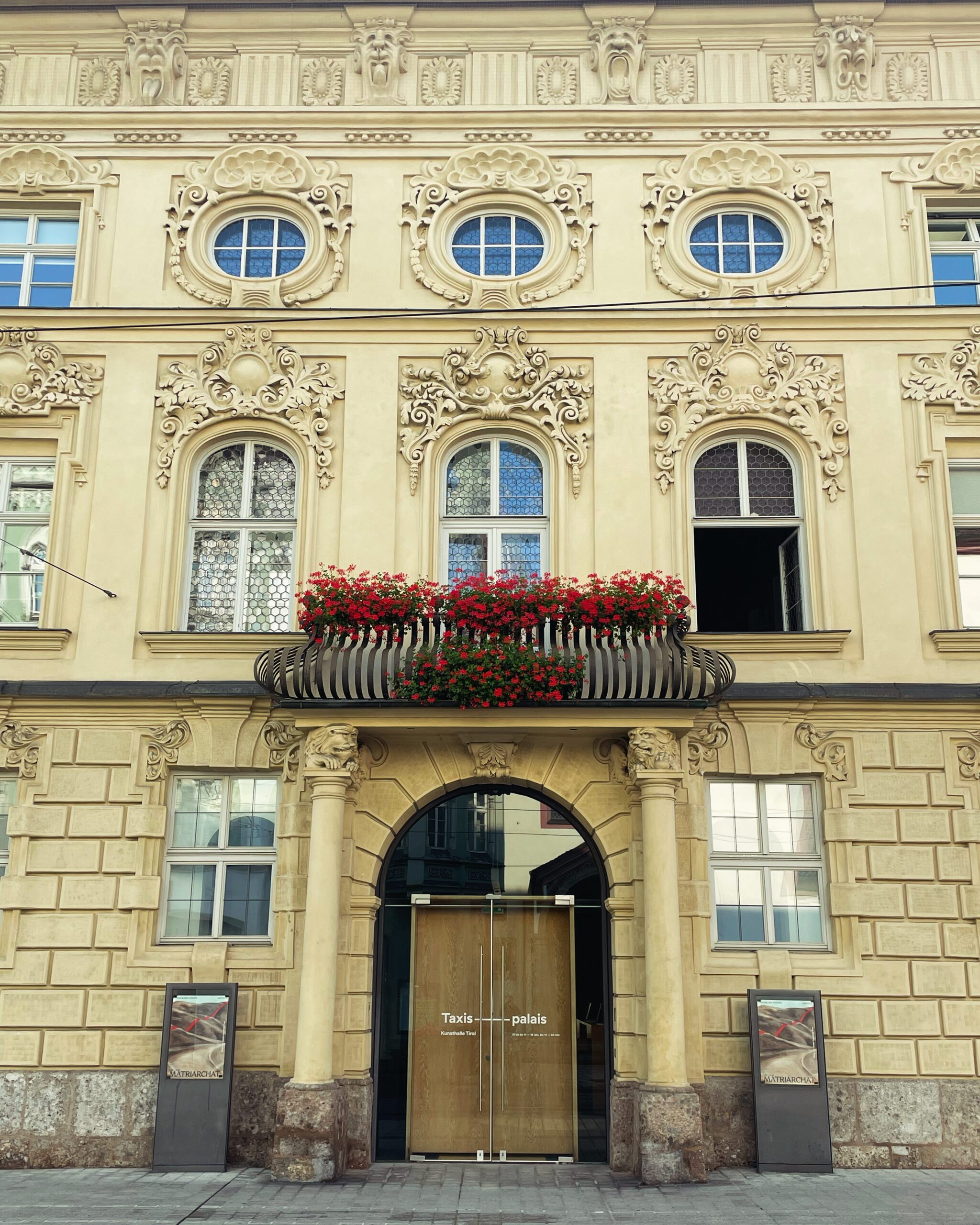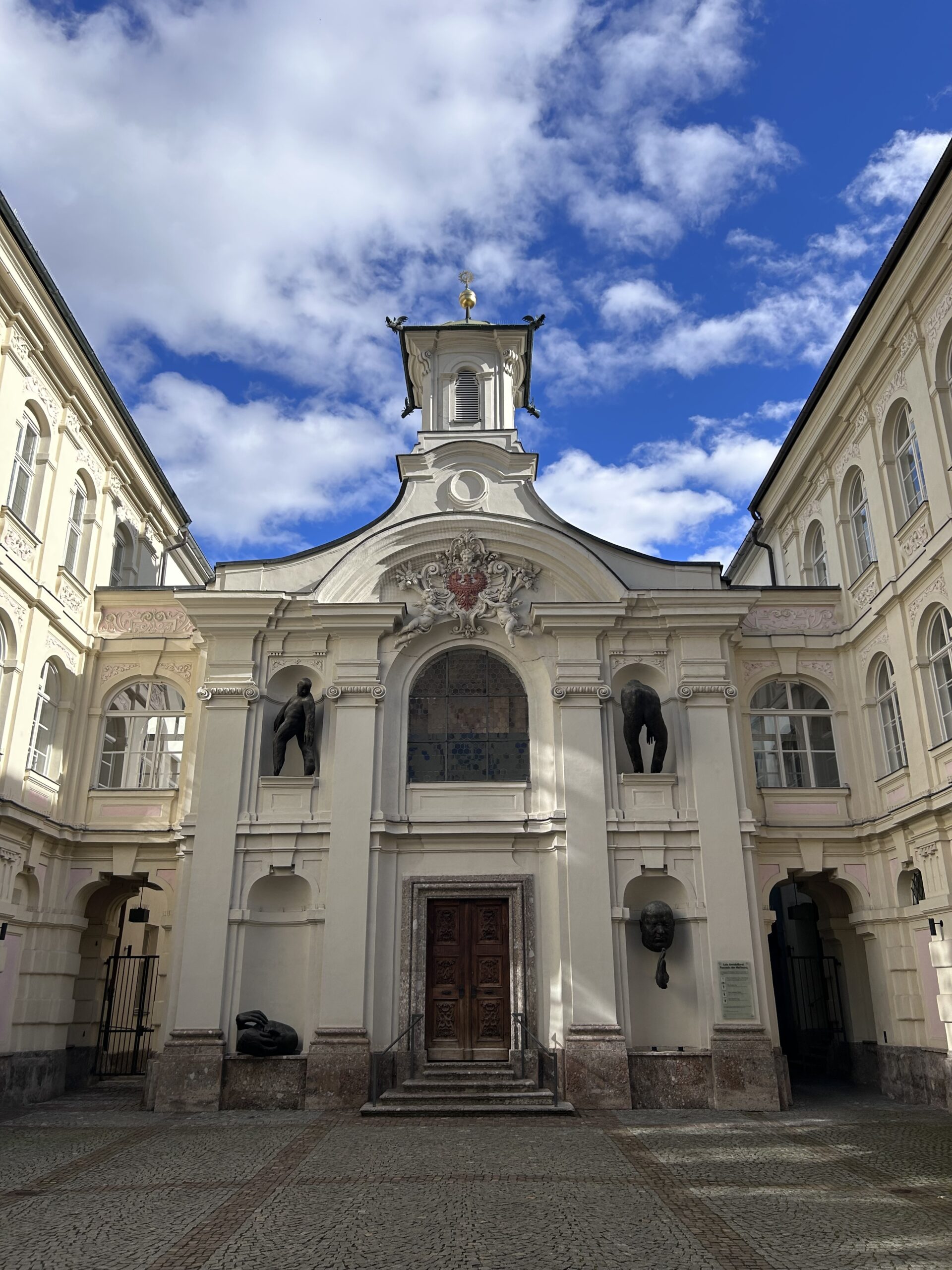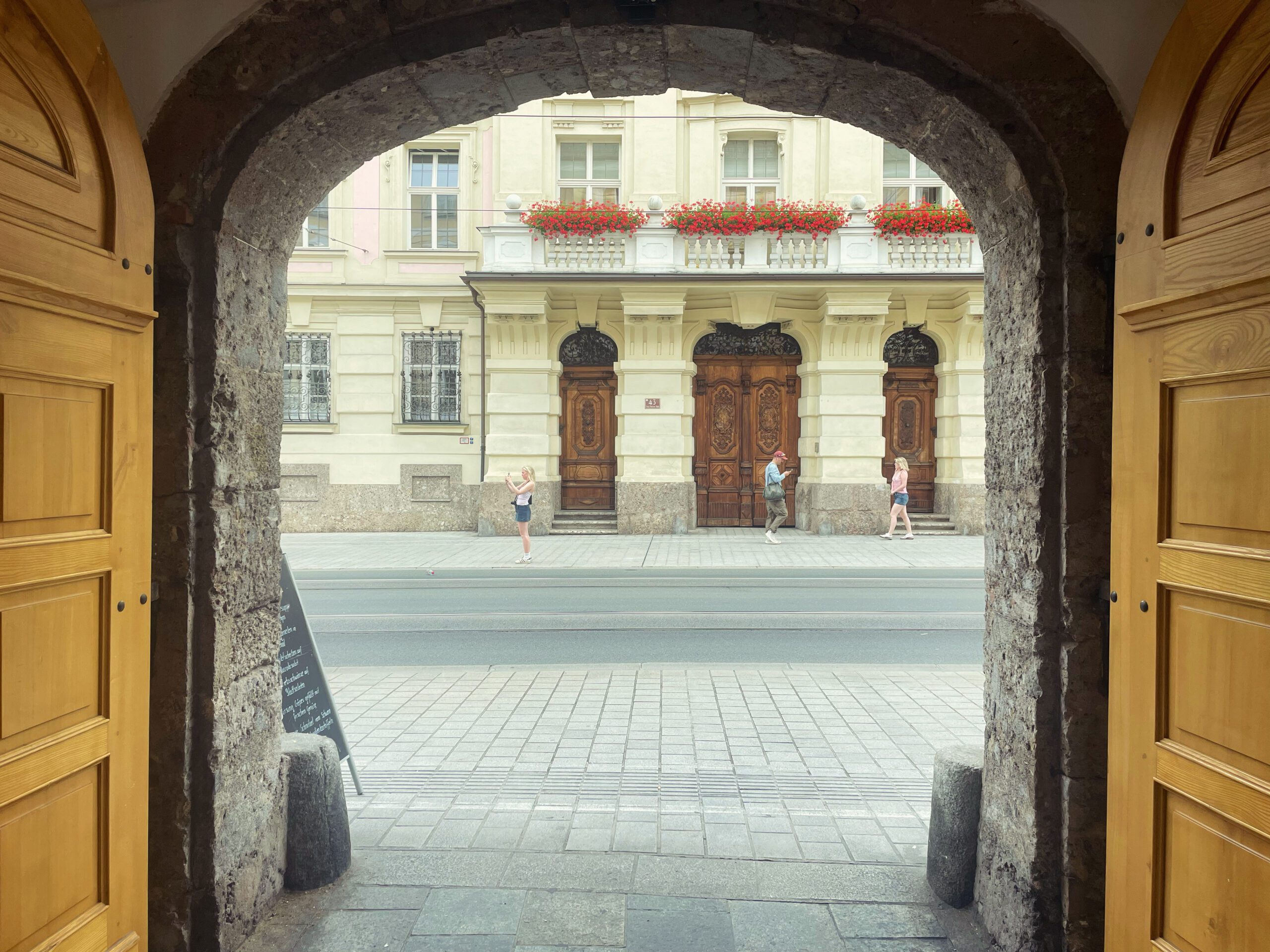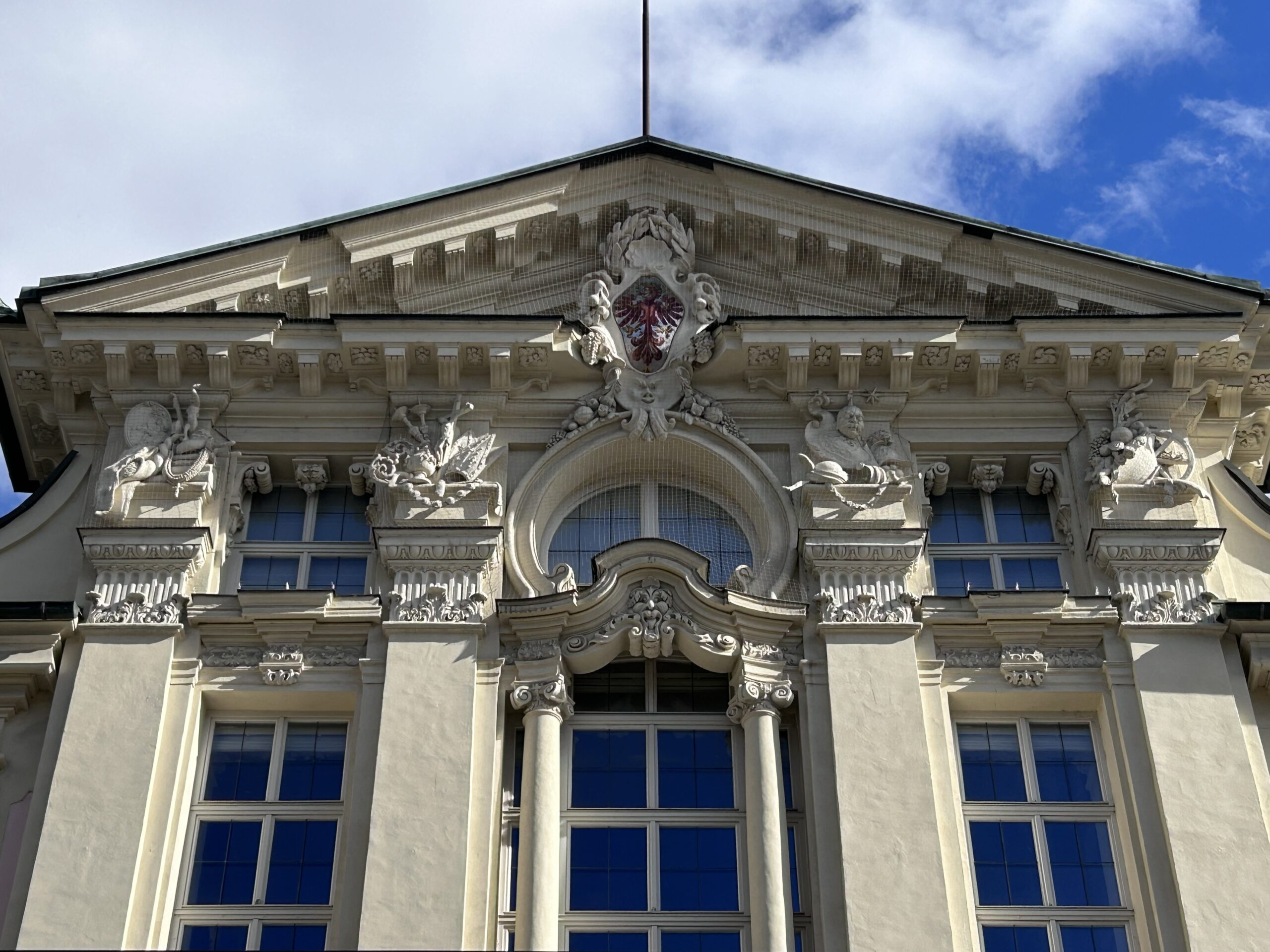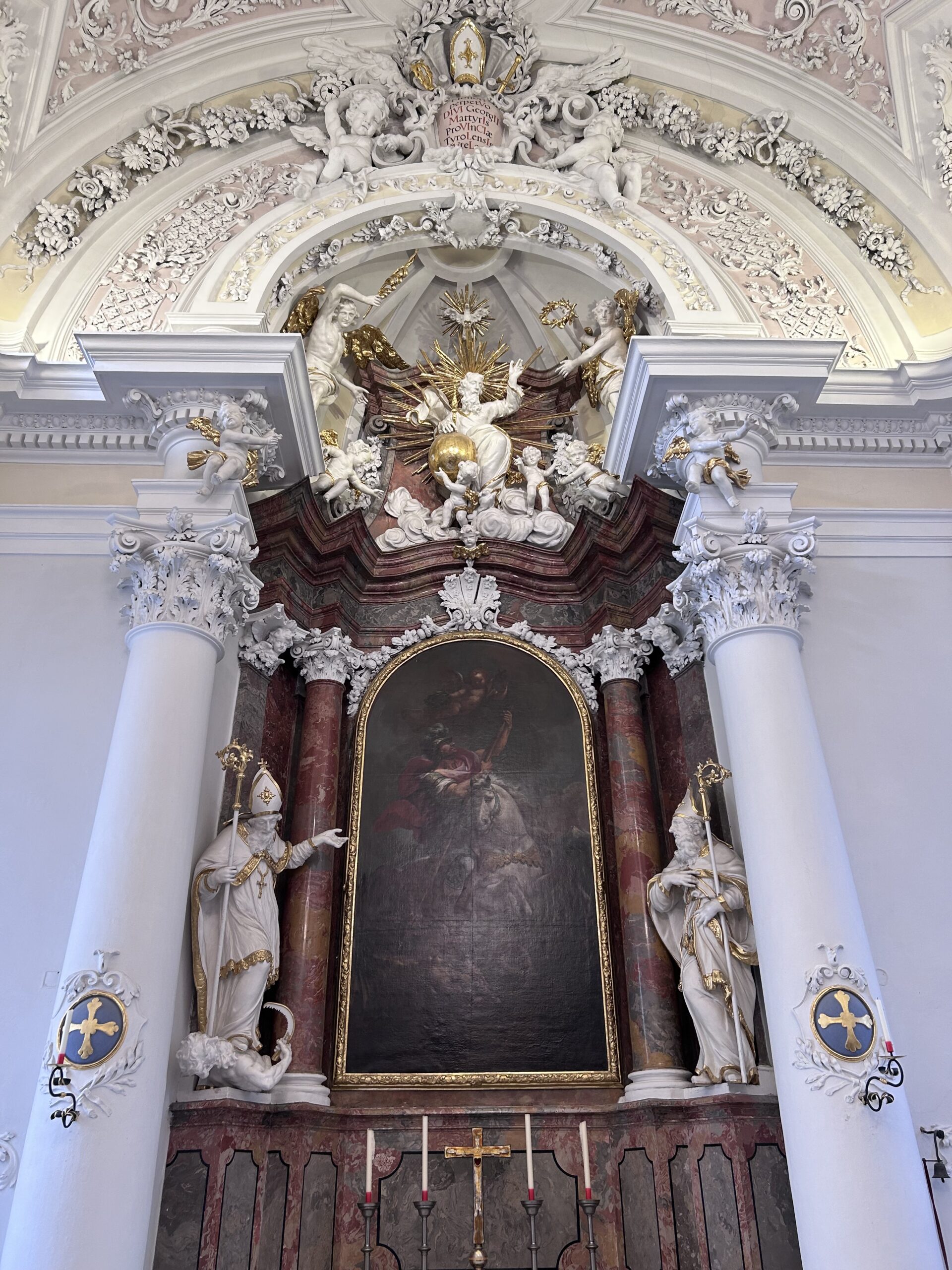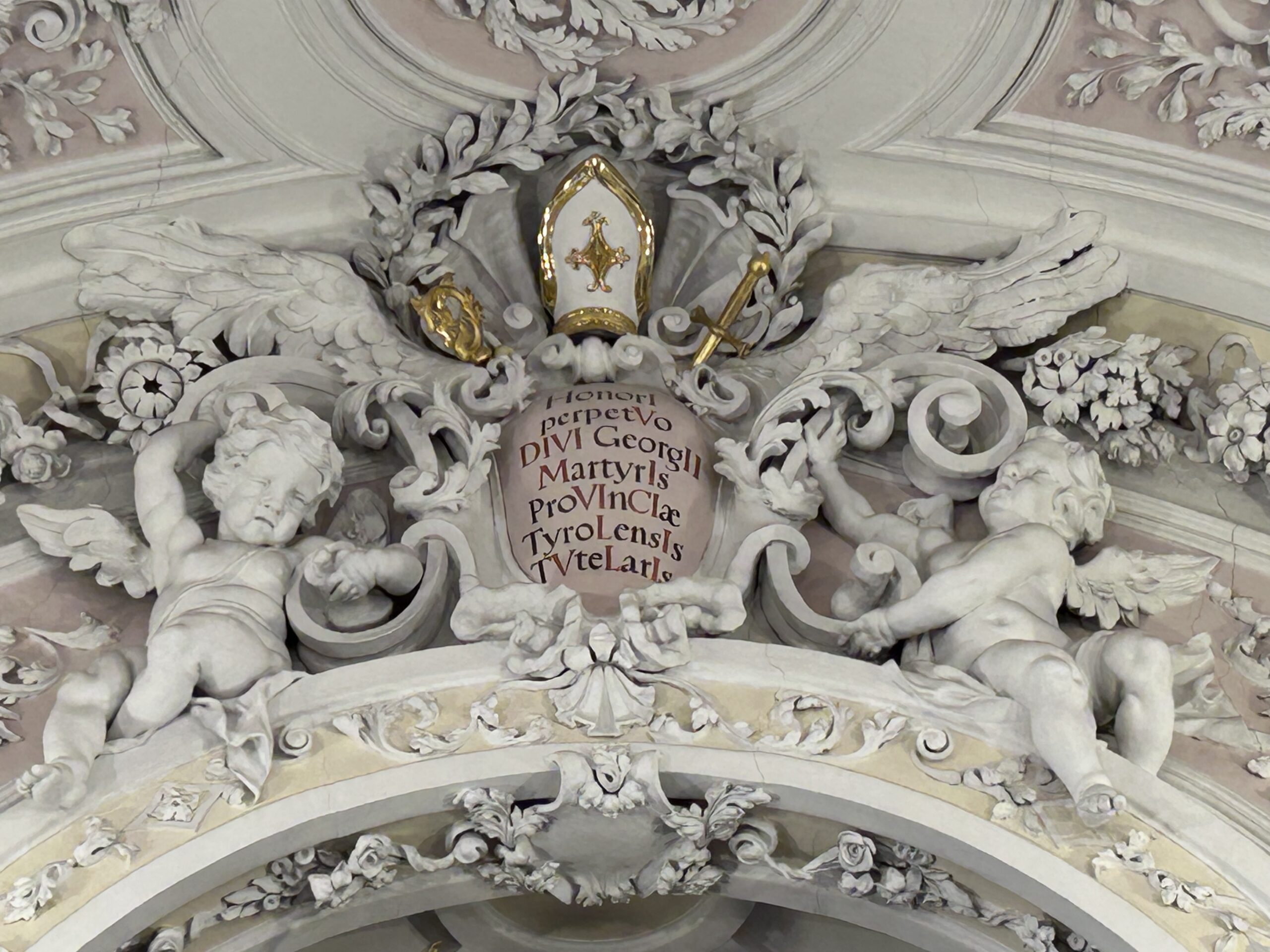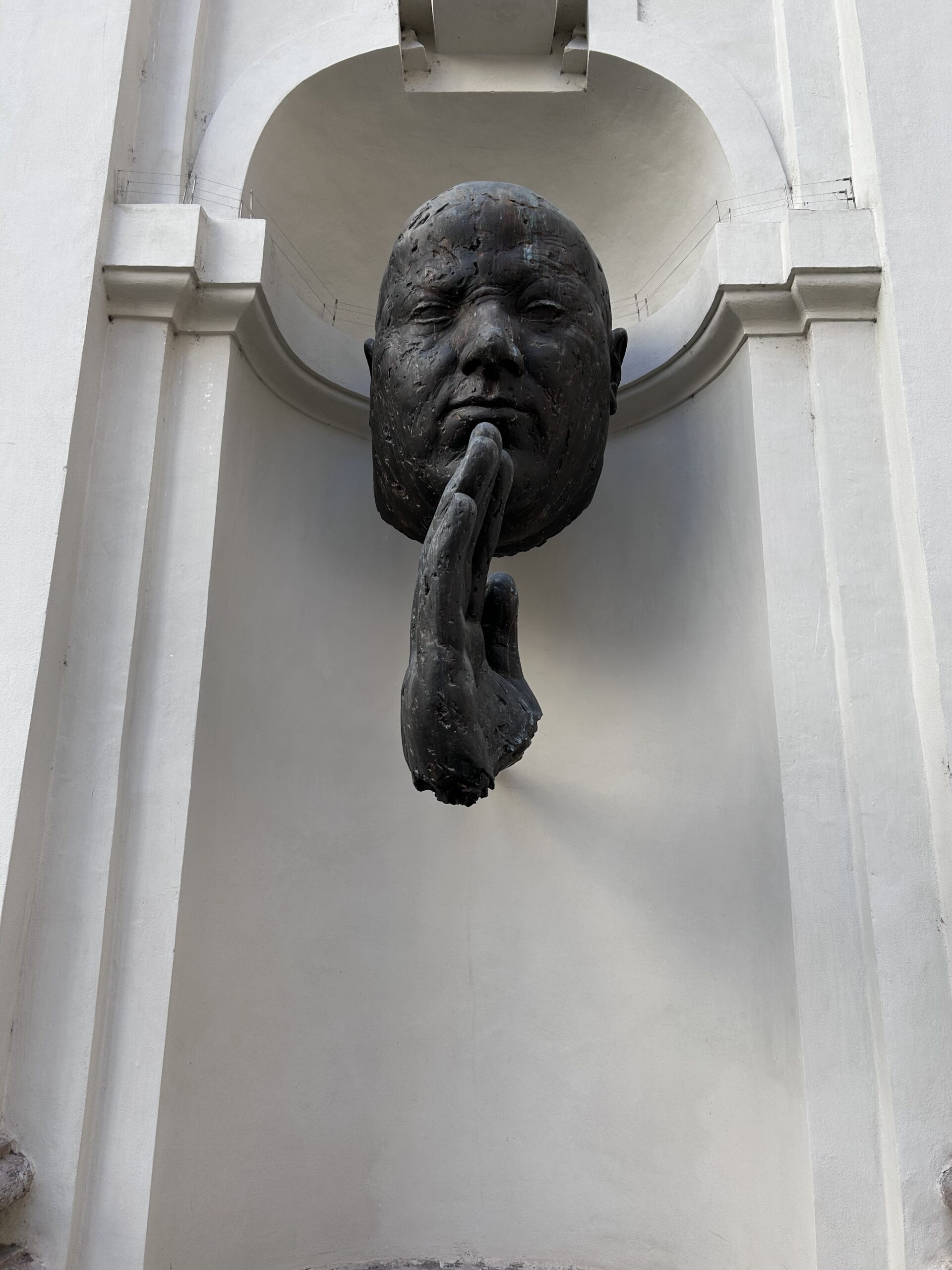Palais Fugger-Taxis & Altes Landhaus
Maria-Theresienstrasse 45 / 43
Worth knowing
In the southern part of Maria-Theresienstraße, two buildings are located right next to each other, symbolising the balance of power and the interplay of Tyrolean business and politics in the early modern era: The Altes Landhaus and the Palais Fugger Taxis. The names Fugger and Taxis stand for early globalisation, capitalism and a change in the world of communication and media. With the Fuggers and the Thurn and Taxis, the palace was home to members of two of the most important families of the early modern era who conducted their business in Innsbruck. If you were to apply today's standards, you would have to use names like Warren Buffett and Mark Zuckerberg to make an adequate comparison. The Palais Fugger taxis zeugt gleichermaßen von den Veränderungen, die die Welt ab 1500 nahm wie von der zunehmenden Bedeutung Innsbrucks als Residenzstadt der Habsburger.
Viele einflussreiche Aristokraten ließen sich im 16. und 17. Jahrhundert in der Neustadt ihre Palazzi errichten, um möglichst nahe am Hof des Tiroler Landesfürsten zu sein. Innsbruck hatte zwar ein wenig an Ansehen verloren seit den Tagen Maximilians, war aber noch immer eine der wichtigsten Städte des Heiligen Römischen Reichs. Nach einem Brand ließ der kaiserliche Geheimrat Graf Hans Otto Fugger ein Palais planen, das alle anderen Stadtpaläste in den Schatten stellen sollte. Wer wenn nicht er sollte sich das leisten können, kam er doch aus der Kaufmannsippe der Augsburger Fugger, einer der reichsten Familien Europas der frühen Neuzeit. Johann Martin Gumpp der Ältere wurde für die Planung engagiert. Zum Vorbild nahm er sich ganz im Chic der Zeit das Genueser Stadtpalais. Der 1679 eröffnete Palast nahm wie die meisten in Innsbruck beim großen Erdbeben von 1689 erheblichen Schaden. Über Heirat kam das Gebäude an die Familie von Welsberg, die es in den folgenden Jahren vermietete. 1784 kaufte Joseph Sebastian von Thurn und Taxis das Palais Fugger, to use it as a residence and post office. The noble family of Thurn und Taxis was one of the most important dynasties of its time. The introduction of the postal system brought them fame, honour and fortune in the empire.
In 1905, the now Palais Fugger taxis in den Besitz des Landes Tirol über, um darin weitere Amtsräume des Landhauses unterzubringen, das sich bereits seit 250 Jahren im Nebengebäude befand. Das Alte Landhaus in seiner heutigen Form entstand erst nach dem Palais der beiden Unternehmerfamilien. Die Tiroler Landesregierung war in der Umstrukturierung nach dem Tod des letzten Habsburgers 1665 und dem Verlust des Status als Residenzstadt zu einem Neustart gezwungen. Fortan sollte nicht mehr ein Landesfürst, sondern ein Gubernator das Land Tirol regieren. Diese Statthalter entstammten zwar auch dem Hochadel, waren aber nicht mehr Besitzer, sondern Verwalter des Landes im Namen der Herrscherfamilie Habsburg. Das Staatsverständnis begann sich zu ändern.1720 wurde das Amt des Tiroler Landeshauptmanns als neue politische Instanz installiert, die zwar keinen Hofstaat aber jede Menge Verwaltungsbeamter mitbrachte. Die Claudiana in the old town was too small for the new government offices, it was decided that the Harnischhaus in the Neustadt, a plater's workshop from the time of Maximilian, as premises for the provincial government. The ornate armour had gone out of fashion in the years following the Thirty Years' War in the age of mercenary armies, firearms and artillery, and the plater's trade suffered the sad economic fate of landline telephones in the 21st century. After a fire in 1620 and the earthquake of 1689, the building was in a desolate state. For decades, however, there was a lack of money and political will to finance a new building. In the times of the French Sun King Louis XIV and his absolutist, centralised approach to government, which became fashionable throughout Europe, representatives of the Habsburg Empire also had a hard time. It was only in the period following the wars of the late 17th century and early 18th century under Charles VI, Maria Theresa's father, that the federal principle was again more strongly emphasised in politics.
Between 1725 and 1734, the new home of the Tyrolean provincial estates and provincial officials was built according to Georg Anton Gumpp's plans. The building had to combine the functions of offices, meeting rooms and representation to the outside world. The baroque façade with its large windows reflects the fashion of the 18th century. The four estates are emblematically represented by crops, armour, a crucifix and a civic chain, which converge under the red eagle, the heraldic animal of Tyrol, on the gable The interior is even more extravagant than the façade. A richly decorated staircase with golden ornaments and statues welcomes the visitor. The ceiling is adorned with the Tyrolean eagle, which holds its protective wings over the historic land of Tyrol and the towns between Trento and Kufstein. Apollo, god of the muses and arts, and his sister Artemis, goddess of the hunt, were sculpted in wood by Nikolaus Moll during the first construction phase. The statues of Athena, the goddess of wisdom, and Ares, the god of war, were added in 1899 in the spirit of historicism. The assembly hall was no less splendidly decorated and is more reminiscent of a sacred building than a parliament. Based on an idea by Martin Stickler, the art-loving Abbot of Wilten, who also supervised the entire project, the six baroque paintings with biblical scenes depicting the individual regions of Tyrol were created. Red marble on the walls and the four man-sized statues of the two Tyrolean governors Charles of Lorraine and Charles III Philip of the Palatinate-Neuburg as well as Emperor Leopold I and Archduke Leopold V dominate the room, which is still used today for provincial assemblies. Four small putti with wine, a knight's helmet, a bishop's mitre and a Roman lictor's bundle symbolise the estates of the peasantry, the nobility, the clergy and the bourgeoisie.
In the inner courtyard of the Landhaus is the Landhaus Chapel of St George, the patron saint of the province of Tyrol, which was also baroqueised in 1728. The saint is commemorated above the altar with the words Honori perpetuo DIVI Georgii Martyris Provinciae Tyrolensis Tutelatis (Note: To the eternal honour of St. George, patron saint of the Tyrol region). The Tyrolean eagle is carried by putti. The modern statues in the niches are a striking feature of the baroque façade. The Ladin sculptor Lois Anvidalfarei interpreted four scenes from the life of St. George to symbolise the battle between good and evil to mark the 200th anniversary of the Battle of Mount Isel in 2009. Evil is not symbolised by a dragon, as in the legend of St. George, but by a human being. If you look at Tyrolean history, especially that of the New country house around the corner, it is quite appropriate to remind people of human ambivalence in a political context.
Thurn und Taxis and the invention of the post office
The 20th and 21st centuries are known as the information age. The internet revolutionised almost every aspect of life. The major changes that took place around 1500 also had a lot to do with new ways of disseminating news. The production and distribution of news, information and ideas was revolutionised thanks to two innovations. The printing press made it easier to reproduce information. Around the same time, a more efficient postal system began to be established in the Holy Roman Empire. The story of the Taxis family, who organised this postal service, is an example of the development opportunities offered by the early modern period around 1500. It is closely linked to the Habsburgs and the city of Innsbruck, which for a short time under Emperor Maximilian was not only the royal seat but also the European postal centre.
The Taxis were a Lombard family from the lower nobility. As early as the 13th century, Omodeo de Tasso had set up a courier service between the major Italian cities in northern Italy. In the Middle Ages, there was no reasonably functioning, transnational postal system of the kind that had existed in ancient Rome. The growing empire under Maximilian, which stretched from the Netherlands via Augsburg and Regensburg to Vienna, needed the most efficient communication possible. To this end, he engaged the Compania de Tassis who set up their own permanent relay line for the emperor, complete with infrastructure and personnel. The brothers Janetto, Francesco and Giovanni Battista de Tassis, in German Franz and Johann Baptist von Taxis, were appointed by Maximilian I as Imperial postmasters made. The emperor wanted to utilise their experience to connect his vast empire with information technology.
At a distance of 20 - 40 km, stations, so-called PostsThe post office in Innsbruck was the first modern postal centre in the early modern period. Innsbruck became the first modern postal centre in the Habsburg Empire in the early modern period. The location at the foot of the Brenner Pass was now not only crucial for trade, but information was also exchanged along this route. The first line ran from Innsbruck to Mechelen from 1489. Soon the route between the Netherlands and Italy was known as the German route known. The post office also brought further administration to Innsbruck. The city was the collection point for the court mail, which was sent from here to the emperor at his respective location. The Court Chancellery in Innsbruck collected the archives with the correspondence and books of the chamber administration. The news, the so-called newspapers, which were sent back and forth between the individual authors and recipients, required the profession of novellists, who compiled and wrote the news.
A few years after Maximilian's death, the Taxis' courier service also opened up to private mail. The Habsburg had been a defaulter and the costs had to be covered. Passenger transport was also offered as a service. On the one hand, this made it possible to reduce the costs of the service, and on the other hand, it allowed them to spy on other participants in the postal system. The postmasters also acted as a kind of secret service. The Counter-Reformation and the military used the postal service for their own purposes. In the individual post offices there were Black chambersin which suspicious letters were opened.
As the Habsburg Empire grew following the expansion of the Habsburgs, so did the Taxis' relay service. In 1505, Philip I of Spain also awarded contracts to the proven service providers on the Iberian Peninsula. After the Italian conquests under Charles V, the Habsburgs also controlled large parts of northern Italy. The information network stretched from Spain to Hungary, from Milan to Brussels.
By controlling European communications, the Taxis gained power, influence and wealth. From 1650, the family called itself Thurn und Taxis. Nothing was left of the old Tasso, which means badger. It was only with the centralisation and the new understanding of the state of the 17th century Enlightenment that their star began to sink. In 1769, the postal regulations of the Taxis family for Vorderösterreich were abolished. The upheavals of the Napoleonic Wars brought further changes. When the Heilige Römische Reich When the Thurn und Taxis were dissolved in 1806, they were only able to claim the postal service for themselves in a few German principalities. The service was increasingly monopolised. Post offices became symbols of the penetration of state power in the public sphere. In 1908, the new main post office was built in Maximilianstraße in Innsbruck according to the plans of Natale Tommasi. As with railway stations, the architecture of the building was no different from other large post offices within the Habsburg Empire. Those who conducted their postal business as subjects of Emperor Franz Joseph I were to be able to do so in the same look and feel throughout the entire monarchy between Trento and Lviv.
After the First World War, the Thurn and Taxis lost their aristocratic privileges. However, many of the castles, estates and palaces throughout Europe are still owned by the family today. Until 1969, opposite the main post office was the Old Post Officewhich at times was also owned by the Thurn und Taxis family. Since the turn of the millennium, the postal service has followed in the footsteps of the Taxis family. Mail order and courier services are increasingly passing into private hands. The state-monopolised postal system of the 20th century was perhaps only a brief intermezzo. Unlike the Taxis family, however, DHL, UPS & CO have to console themselves with filthy lucre and are not elevated to the nobility. The Palais Fugger-Taxis in Innsbruck, on the other hand, is still a reminder of the emperor's postmasters.
Jakob Fugger: the richest man in history
There is hardly an uncrowned person who had a greater influence on the history of Europe until the 20th century than Jakob Fugger (1459 - 1525). Not only did his lifetime coincide with that of Emperor Maximilian, the fates of the two men were closely linked. The history of Tyrol was also shaped by the most important financial magnate of his time.
Jakob Fugger came from a family of merchants in Augsburg. The arrival of the progenitor of the family was recorded in the Augsburg tax book under "Fucker advenit". In the 15th century, a Fugger trading network of factories gradually developed. The merchants founded factories in Venice, Bolzano, Milan, Nuremberg, Frankfurt, Bruges and Antwerp for their textile business. Factories were a multifunctional mix of sales area, financial branch, horse station, warehouse, post and news centre and diplomatic representation. This system had spilled over the Alps from northern Italy. An early form of financial capitalism had emerged in the region between Florence, Venice and Milan. Banking began its triumphal march through Europe here in the late Middle Ages. Merchants who did not want to carry vast amounts of cash with them needed so-called bills of exchange to carry out their transactions. They therefore began to set up branch offices in the major trading cities. Italian financial institutions also had branches in Innsbruck from the High Middle Ages onwards.
Jakob and his brothers also initially traded cotton with the wealthy northern Italian cities in the good family tradition. In Venice, the financial centre of the eastern Mediterranean, Jakob Fugger became acquainted with the art of double-entry bookkeeping and the intricacies of progressive Italian finance. He realised that there was more to be earned from money transactions and loans than from cotton. The monarchs and aristocrats of Europe financed their courts and wars in the Middle Ages through the Tithe. This tax was paid by the peasants within the feudal system. Warfare in particular had become increasingly expensive in the 15th century, fuelled by modern firearms. As a result, the tithe was often no longer sufficient. The legitimisation as God's representative on earth had worked for monarchs up to this point, but around 1500, the sounding coin and interest in the form of financial capitalism slowly but surely began to replace God as the ultimate authority.
Jakob Fugger's relationship with the House of Habsburg, and in particular with Tyrol, began to intensify in 1487. The Tyrolean sovereign Siegmund was defeated in a military conflict with the Republic of Venice. In order to pay his debt of 100,000 guilders to the Mediterranean power, he borrowed money from the Fuggers. In return, he issued promissory notes, which he covered by pledging the Schwaz silver mine to his lenders. Schwaz was the largest silver mine in the world before the development of the American silver mines. The Fuggers sold the Schwaz silver to the Hall mint, which they also operated, and in turn lent these coins to Duke Siegmund. A special kind of cycle was born.
However, this was not the end of the Fuggers' political influence on world politics. When the Tyrolean estates deposed Siegmund in 1490 due to his disastrous business behaviour, Maximilian I succeeded him as Prince of Tyrol. Fugger was clever enough to back the new sovereign. The word credit, which goes back to the Latin credereThe choice shows that he believed in Maximilian. Fugger believed in a powerful Maximilian as his best asset. He financed Maximilian's election as Holy Roman Emperor in 1493, thereby securing his influence and elevation to the nobility. It was also Fugger who sponsored the double wedding in Vienna, Maximilian's masterpiece of marriage policy, which made Hungary part of the Habsburg Empire. When Maximilian died in 1519, Fugger repeated this and used his financial power to have Maximilian's grandson Charles V elected emperor. A loan of 540,000 guilders went from the Fuggers to the Habsburgs to pay for advertising and bribes. In return, Charles V granted Fugger rights to mines in Spain and South America, where slaves worked under inhumane conditions to keep this wheel of exploitation and corruption turning
The Fuggers granted the Habsburgs an estimated two million guilders in loans between 1487 and 1525 alone. One florin was equivalent to 60 crowns. A day labourer earned around 6 crowns at that time. This sum could have been used to employ almost 55,000 people a day for a year. A large part of this debt was paid off with rights of use to Tyrolean assets and increased taxes. It is estimated that at the time of his death, Fugger's financial empire handled around 50% of the Tyrolean state budget and 10% of the Tyrolean state's assets. Heiligen Römischen Reiches possessed. His officials managed mines in Tyrol, the Czech Republic, Slovakia and Spain, financed trading expeditions throughout the then known world and numerous wars in Europe. Some historians consider Jakob Fugger to be the richest man in world history. How high his fortune was is difficult to convert to today's standards. When the FAZ made an attempt in 2016, it came up with 300 billion dollars. Like Maximilian I, Jakob Fugger was both a man of power and an educated, devout Catholic. Corruption, exploitation, the financing of wars and, out of fear of God and purgatory, the FuggereiThe idea of founding the world's first social housing estate in Augsburg was not out of the question.
In Innsbruck, the Palais Fugger-Taxis and a small alley between Maria-Theresien-Straße and Landhausplatz commemorate the Fuggers. No reference is made to the way in which the merchant dynasty became wealthy.
Innsbruck - city of bureaucrats and civil servants
Innsbruck is proud of its many titles. University city, Austria's capital of sport or home to the world's best hospital. If you take a look at the list of the region's largest employers or at its history, Innsbruck is one thing above all: a city of civil servants. The university and provincial hospital are the largest single employers. However, if you add up the public servants at all levels, city, state and federal, and include the outsourced companies owned by the public sector such as ÖBB, TIWAG or Innsbrucker Kommunalbetriebe as well as teachers and the police, the civil servants are clearly in the majority. At the latest since the relocation of the royal residence under Frederick IV, civil servants have not only made up a considerable proportion of the city's population in quantitative terms, they have also determined the fate of the city in an influential, albeit inconspicuous manner. To this day, it is civil servants who keep things running smoothly. They enforce laws, take care of the planning and maintenance of infrastructure, eagerly keep records of the population in order to collect taxes and draft soldiers.
Die erste nennenswerte Bürokratie kam wohl mit dem Roman Empire. Den Römern folgten im frühen Mittelalter die Brüder des Stiftes Wilten. Die schreibkundigen Männer verwalteten nicht nur die herzoglichen und eigenen Besitztümer durch ihre Urbare und hoben die Abgaben bei den bäuerlichen Untertanen ein, sondern legten Taufmatrikel, Heiratsverzeichnisse und Sterbebücher an. Die Feudalherrschaft erforderte zwar einen Panoramablick über das, was sich innerhalb ihres Herrschaftsbereichs abspielte, vor allem in der Stadt war das Leben aber eher von den Beschränkungen der Zünfte als von denen der Obrigkeit bestimmt. Ein Magistrat war nur oberflächlich vorhanden. Es gab Gesetze, aber keine Polizei, Steuern aber kein Finanzamt. Städtische Infrastruktur war praktisch nicht vorhanden, schließlich gab es weder fließend Wasser, elektrischen Strom, Kanalisation, städtische Kindergarten, ein Arbeitsamt oder eine Krankenkasse. Die zur Stadt erhobene Gemeinde Innsbruck wurde lange von einem Stadtrichter, ab dem 14. Jahrhundert von einem Bürgermeister mit Gemeinderat regiert. Es handelte sich dabei nicht um hauptberufliche Beamte, sondern Mitglieder der städtischen Elite. Nur wenige Menschen wie Zöllner, Kornmesser, Schreiber oder Turmwächter standem bei der Stadt unter Lohn und Brot.
Im 15. Jahrhundert wurden Berufswelt und Gesellschaft differenzierter, die Heere größer und die Steuerbelastungen höher. Das traditionelle Gewohnheitsrecht wurde vom modernen, für Unkundige schwerer durchschaubaren Römischen Recht abgelöst. Mit der Stadt wuchs auch der Beamtenapparat. Zwischen Anfang des 15. Jahrhunderts und der Regierung Leopolds V. war Innsbruck von einer Handels- und Transportsiedlung zu einer Beamtenstadt geworden. Von den circa 5500 Einwohnern gehörte mehr als die Hälfte dem Hofstaat, der städtischen Beamtenschaft, der Universität oder dem Klerus an. Hofhaltung, Verwaltung, Zoll, Steuern, Fernhandel und Finanzwirtschaft benötigten schreibkundiges Personal. Die Verwaltung war, vor Handwerk, Transport und Gastronomie zum wichtigsten Wirtschaftszweig der Stadt geworden.
Wenn überhaupt kamen die Bürger mit diesen fremden Beamten nur in unangenehmen Situationen in Berührung. Besonders straff wurden die Zügel von Maximilian I. angezogen. Seine zentral beschlossenen Gesetze wurden von den Reichskreisen lokal umgesetzt. Die besoldeten Beamten durchdrangen das Leben des Einzelnen in einer Art und Weise, die es im Mittelalter so nicht gab. Zu allem Übel kamen die Beamten oft aus dem Ausland. Besonders Italiener und Burgunder waren gefragte Schlüsselarbeitskräfte, die aber mit der einheimischen Bevölkerung fremdelten. Nicht nur sprachen sie oft kein Deutsch, sie konnten lesen und schreiben, waren Angestellte und keine untertänigen Landwirten. Sie hatten mehr Geld zur Verfügung, kleideten sich anders, hatten andere Sitten und aßen andere Speisen. Anders als der Landesfürst beriefen sie sich nicht auf Gott, sondern auf von Menschen geschriebene, von der Antike und der Vernunft inspirierte Regelwerke. Je nach Mode, Sitte und Moralvorstellung der Zeit, änderten sich die Gesetze. So wie Naturschutz oder Tempolimits auf Autobahnen heute immer wieder zur Diskussion gestellt werden, obwohl sie Sinn machen, wurden damals Verbote von Ausspucken, Entsorgung des Nachttopfes, Holzbauten und Viehhaltung innerhalb der Stadtmauern kritisch gesehen, obwohl sie Hygiene und Sicherheit drastisch erhöhten.
While it had long been customary for citizens to take certain liberties with logging, building, hunting and fishing in the absence of the ruler, the bureaucracy was always present. While the sovereign was seen as a good father to his subjects and bishops and abbots were strict landlords, but could at least offer salvation in return, the new authorities appeared anonymous, aloof, faceless, foreign and distant. The basis for negotiation that you had as a subject in direct contact with your landlord was buried by the merciless law, at least if you could not pay bribes or did not know anyone in a higher position. When unconditional faith in the increasingly corrupt clergy began to crumble and Ferdinand I appointed the Spaniard Salamanca as the country's chief financial administrator, the underlying dissatisfaction turned into open rebellion in 1525. The subjects did not demand the removal of the prince, but a change in the rule of the clergy and foreign officials. Even in the 17th century, it was the country's highest civil servant, Wilhelm Biener, whose head rolled and not that of the sovereign.
Bureaucracy, the rule of the administration, also had advantages for the subjects. It established fixed rules where arbitrariness often prevailed. The law, harmonised across different territories, was more predictable. And with a bit of luck and talent, it was possible to climb the social ladder by serving the public authorities, even without belonging to the nobility. Michael Gaismair, one of the leaders of the 1525 rebellion, was the son of a mining entrepreneur and had been in the service of the provincial governor before his career as a revolutionary.
The next modernisation of the administration took place in the 18th century. Under the enlightened, absolutist monarchs Maria Theresa and Joseph II, a new wind blew right down to the municipal level. Innsbruck was given a police force for the first time. The city administration was modernised in 1784. Instead of the old city council with Common regierte nun ein von einem Rat, vor allem aber von Beamten unterstützter, offiziell in Sold und Brot des Staates stehender Bürgermeister. Fünf angestellte Magistratsräte und sechs unbesoldete Magistratsräte, und über 30 Beamte bildeten das Stadtmagistrat. Er bestand damit nicht mehr aus Laien, sondern zu einem großen Teil aus Experten, die zwar immer noch vorwiegend aus Mitgliedern des Kleinadels bestanden, sich nun aber durch Prüfungen für die Ausübung ihres Amtes qualifizieren mussten. Die Bürokratie erhielt auf operativer politischer Ebene mehr Macht. Während der Bürgermeisterposten zeitlich begrenzt war, kamen Beamte in den Genuss einer lebenslangen, unkündbaren Stellung. Diese Pragmatisierung und ein neuerlicher Schwall an neuen, oftmals den Traditionen widersprechenden Gesetzen, verstärkten den Ruf der Beamten, abgehoben und bürgerfern zu sein. Als mit der bayerischen Besetzung Tirols das Element des ausländischen, noch dazu nach französischem Vorbild, dazukam, brach 1809 erneut ein Aufstand aus. Die Massenaushebung junger Männer für den Militärdienst, eine Reglementierung des religiösen Lebens und eine Impfpflicht, durchgesetzt von bayerischen Beamten, war zu viel für die Tiroler Seelenlandschaft.
After 1809, bureaucracy found its way into more and more areas of life in the context of industrialisation and new technologies. Not only the state system through taxes and the military, but also the university, schools, construction, railway, post office and institutions such as the Chamber of Commerce and Industry required administrative staff. The city grew in terms of inhabitants and businesses. New infrastructure such as gas, sewerage and electricity and new ideas about hygiene, food control, health and education called for new employees in the city magistrate's office. The old town hall in the historic city centre became too small. A planned extension proved to be impossible. In 1897, the officials moved to the new town hall in Maria-Theresien-Straße. The move was made possible by a generous donation from the industrialist and hotelier Leonhard Lang. In 1905, the Tyrolean provincial government and its various offices found a new home for a short time in Palais Fugger-Taxis before moving to the Gauhaus on Landhausplatz.
Als 1918 die Monarchie zusammenbrach, war der Übergang nicht nahtlos, dank der Strukturen verlief er aber unvorstellbar glatt. Es war aber nicht mehr der Kaiser, der die Last des Staates trug, sondern eine Heerschar an Staatsbediensteten und Hütern der Ordnung, die für Wasser, Strom und ein funktionierendes Eisenbahnnetz sorgten. Mit Eduard Klingler und Theodor Prachensky hinterließen zwei Bauamtsleiter in der ersten Hälfte des 20. Jahrhunderts ihre bis heute gut sichtbaren Spuren im Innsbrucker Stadtbild. Die Republik übernahm mit Agenden wie dem öffentlichen Wohnbau, dem Arbeitsamt, dem Bildungswesen, der städtischen Infrastruktur, Straßenbau, öffentlichem Verkehr bis hin zu Meldewesen und Hochzeit mehr oder minder alle Aufgaben des täglichen Lebens von Monarchie und Kirche. Wer sich also beim nächsten Besuch im Neuen Rathaus über überbordendes Beamtentum und quälend langsame Bürokratie ärgert, dem sei in Erinnerung gerufen, dass der Wohlfahrtsstaat in Person seiner Staatsdiener von der Wiege bis zur Bahre das soziale Auskommen und öffentliche Infrastruktur Tausender Menschen meist unbemerkt managed.
The master builders Gumpp and the baroqueisation of Innsbruck
The works of the Gumpp family still strongly characterise the appearance of Innsbruck today. The baroque parts of the city in particular can be traced back to them. The founder of the dynasty in Tyrol, Christoph Gumpp (1600-1672), was actually a carpenter. However, his talent had chosen him for higher honours. The profession of architect or artist did not yet exist at that time; even Michelangelo and Leonardo da Vinci were considered craftsmen. After working on the Holy Trinity Church, the Swabian-born Gumpp followed in the footsteps of the Italian master builders who had set the tone under Ferdinand II. At the behest of Leopold V, Gumpp travelled to Italy to study theatre buildings and to learn from his contemporary style-setting colleagues his expertise for the planned royal palace. Comedihaus polish up.
His official work as court architect began in 1633. New times called for a new design, away from the Gothic-influenced architecture of the Middle Ages and the horrors of the Thirty Years' War. Over the following decades, Innsbruck underwent a complete renovation under the regency of Claudia de Medici. Gumpp passed on his title to the next two generations within the family. The Gumpps were not only active as master builders. They were also carpenters, painters, engravers and architects, which allowed them to create a wide range of works similar to the Tiroler Moderne around Franz Baumann and Clemens Holzmeister at the beginning of the 20th century to realise projects holistically. They were also involved as planners in the construction of the fortifications for national defence during the Thirty Years' War.
Christoph Gumpp's masterpiece, however, was the construction of the Comedihaus in the former ballroom. The oversized dimensions of the then trend-setting theatre, which was one of the first of its kind in Europe, not only allowed plays to be performed, but also water games with real ships and elaborate horse ballet performances. The Comedihaus was a total work of art in and of itself, which in its significance at the time can be compared to the festival theatre in Bayreuth in the 19th century or the Elbphilharmonie today.
His descendants Johann Martin Gumpp the Elder, Georg Anton Gumpp and Johann Martin Gumpp the Younger were responsible for many of the buildings that still characterise the townscape today. The Wilten collegiate church, the Mariahilfkirche, the Johanneskirche and the Spitalskirche were all designed by the Gumpps. In addition to designing churches and their work as court architects, they also made a name for themselves as planners of secular buildings. Many of Innsbruck's town houses and city palaces, such as the Taxispalais or the Altes Landhaus in Maria-Theresien-Straße, were designed by them. With the loss of the city's status as a royal seat, the magnificent large-scale commissions declined and with them the fame of the Gumpp family. Their former home is now home to the Munding confectionery in the historic city centre. In the Pradl district, Gumppstraße commemorates the Innsbruck dynasty of master builders.
Baroque: art movement and art of living
Anyone travelling in Austria will be familiar with the domes and onion domes of churches in villages and towns. This form of church tower originated during the Counter-Reformation and is a typical feature of the Baroque architectural style. They are also predominant in Innsbruck's cityscape. Innsbruck's most famous places of worship, such as the cathedral, St John's Church and the Jesuit Church, are in the Baroque style. Places of worship were meant to be magnificent and splendid, a symbol of the victory of true faith. Religiousness was reflected in art and culture: grand drama, pathos, suffering, splendour and glory combined to create the Baroque style, which had a lasting impact on the entire Catholic-oriented sphere of influence of the Habsburgs and their allies between Spain and Hungary.
The cityscape of Innsbruck changed enormously. The Gumpps and Johann Georg Fischer as master builders as well as Franz Altmutter's paintings have had a lasting impact on Innsbruck to this day. The Old Country House in the historic city centre, the New Country House in Maria-Theresien-Straße, the countless palazzi, paintings, figures - the Baroque was the style-defining element of the House of Habsburg in the 17th and 18th centuries and became an integral part of everyday life. The bourgeoisie did not want to be inferior to the nobles and princes and had their private houses built in the Baroque style. Pictures of saints, depictions of the Mother of God and the heart of Jesus adorned farmhouses.
Baroque was not just an architectural style, it was an attitude to life that began after the end of the Thirty Years' War. The Turkish threat from the east, which culminated in the two sieges of Vienna, determined the foreign policy of the empire, while the Reformation dominated domestic politics. Baroque culture was a central element of Catholicism and its political representation in public, the counter-model to Calvin's and Luther's brittle and austere approach to life. Holidays with a Christian background were introduced to brighten up people's everyday lives. Architecture, music and painting were rich, opulent and lavish. In theatres such as the Comedihaus dramas with a religious background were performed in Innsbruck. Stations of the cross with chapels and depictions of the crucified Jesus dotted the landscape. Popular piety in the form of pilgrimages and the veneration of the Virgin Mary and saints found its way into everyday church life.
The Baroque piety was also used to educate the subjects. Even though the sale of indulgences was no longer a common practice in the Catholic Church after the 16th century, there was still a lively concept of heaven and hell. Through a virtuous life, i.e. a life in accordance with Catholic values and good behaviour as a subject towards the divine order, one could come a big step closer to paradise. The so-called Christian edification literature was popular among the population after the school reformation of the 18th century and showed how life should be lived. The suffering of the crucified Christ for humanity was seen as a symbol of the hardship of the subjects on earth within the feudal system. People used votive images to ask for help in difficult times or to thank the Mother of God for dangers and illnesses they had overcome. Great examples of this can be found on the eastern façade of the basilica in Wilten.
The historian Ernst Hanisch described the Baroque and the influence it had on the Austrian way of life as follows:
„Österreich entstand in seiner modernen Form als Kreuzzugsimperialismus gegen die Türken und im Inneren gegen die Reformatoren. Das brachte Bürokratie und Militär, im Äußeren aber Multiethnien. Staat und Kirche probierten den intimen Lebensbereich der Bürger zu kontrollieren. Jeder musste sich durch den Beichtstuhl reformieren, die Sexualität wurde eingeschränkt, die normengerechte Sexualität wurden erzwungen. Menschen wurden systematisch zum Heucheln angeleitet.“
The rituals and submissive behaviour towards the authorities left their mark on everyday culture, which still distinguishes Catholic countries such as Austria and Italy from Protestant regions such as Germany, England or Scandinavia. The Austrians' passion for academic titles has its origins in the Baroque hierarchies. The expression Baroque prince describes a particularly patriarchal and patronising politician who knows how to charm his audience with grand gestures. While political objectivity is valued in Germany, the style of Austrian politicians is theatrical, in keeping with the Austrian bon mot of "Schaumamal".
